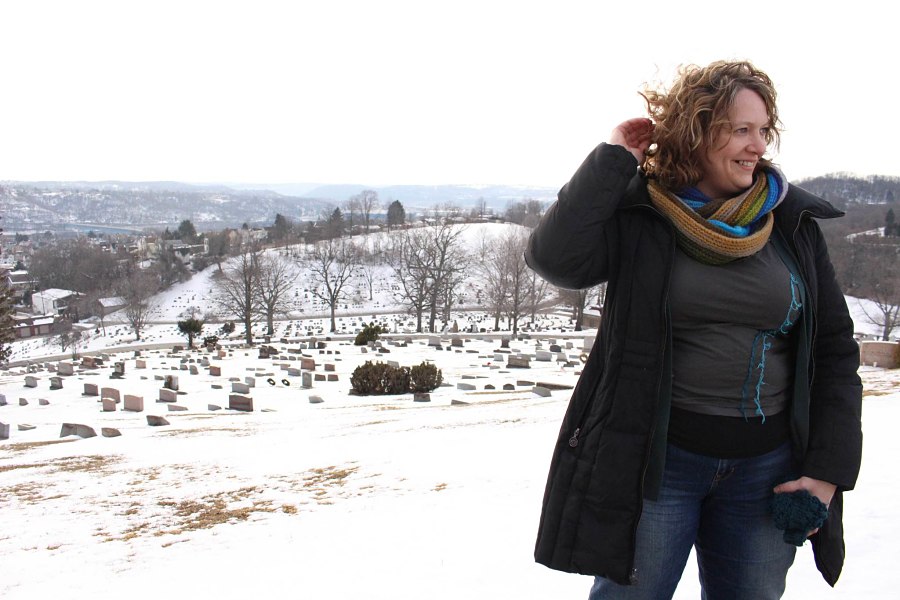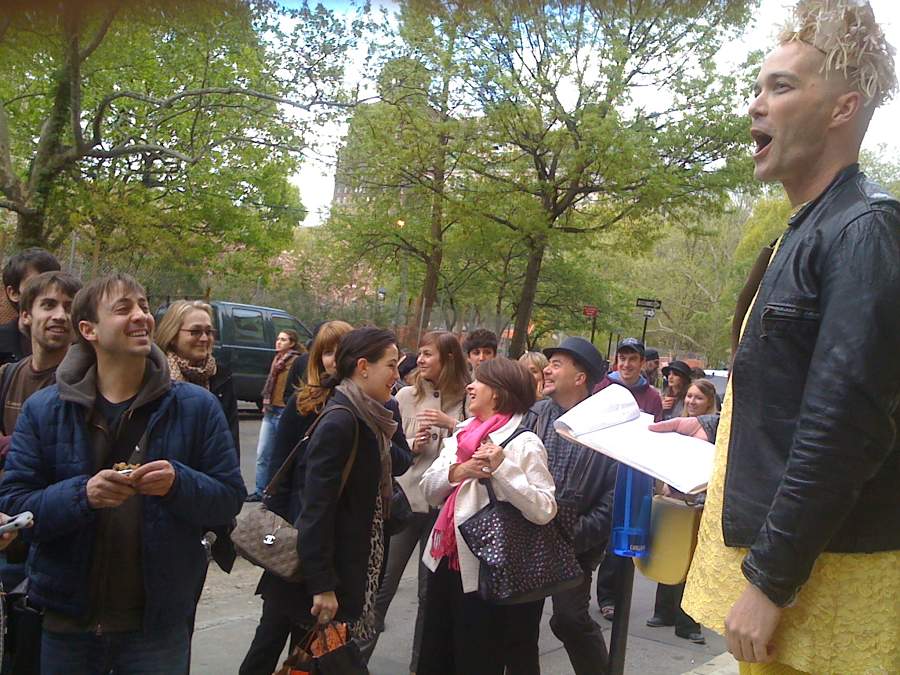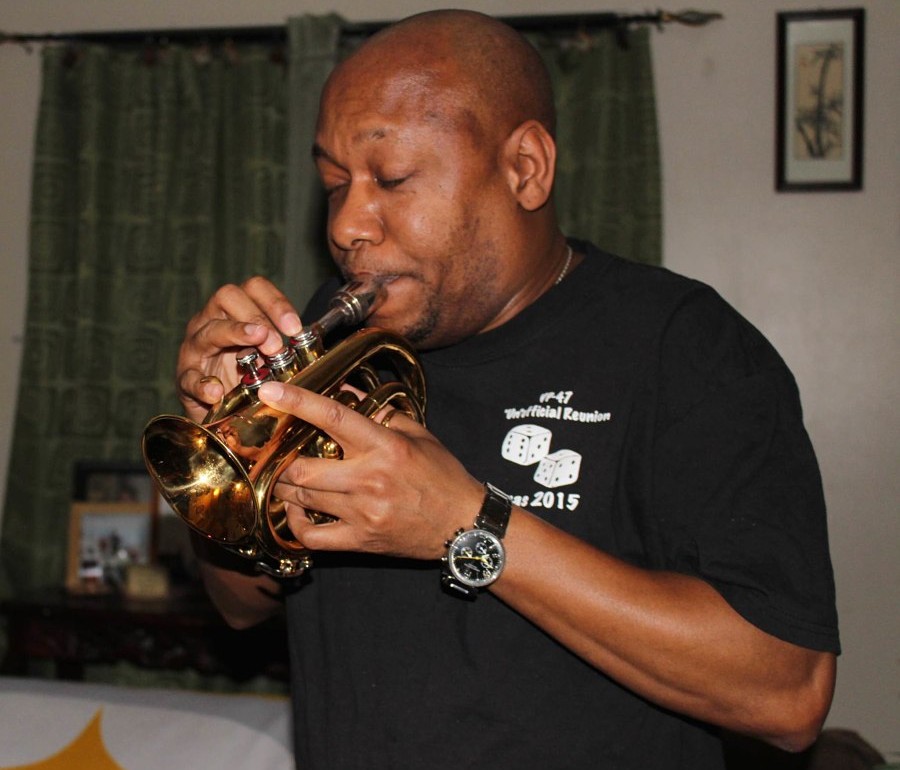For her next play, Molly Rice doesn’t have to build a traditional set. She and her collaborators are working to construct something more complicated: community.
The show, the latest incarnation of Rice’s Saints Tour project, opens May 21. By then, playwright Rice and her team will have logged hundreds of hours learning about and making connections in Braddock, Pa., the small, struggling, largely African-American mill town in the Monongahela Valley just outside Pittsburgh that’s the setting of this immersive, site-specific work.
One sunny Saturday in March, Rice and her collaborators are trekking through Braddock’s boarded-up streets to the home of Sanford-Mark Barnes, a gregarious crossing guard, and three of his sons. The Saints crew—which includes Rice’s partner, Rusty Thelin, with whom she comprises the company Real/Time Interventions, as well as Jeffrey Carpenter and Tami Dixon of Pittsburgh’s Bricolage Production Company—had first met Barnes nearly a year earlier, at a community arts event. The former professional musician and Star Trek aficionado was taken with their vision of a theatrical work that would tour his town and highlight its residents. They all became friends, and began gathering for social occasions like tonight’s family-style meal, featuring Barnes’s pasta.
After dinner, Rice elaborates on the show’s premise. The idea for The Saints Tour–Braddock is that Braddock is a special place where, at just this time of year, saints are likely to emerge in corporeal form. Audiences led by a “tour guide,” traveling by school bus and on foot, are told they might witness just such an emergence.
Today, Rice formally requests Barnes’s involvement in the show—and perhaps even that of his young sons, who sing, play drums and do spoken-word poetry. Recalling Barnes’s expertise on the trumpet, Rice suggests that his role might be to appear on the tour route, blowing loudly enough to draw the audience onward. “You’re the herald,” she says. “The trumpeter.”
“Gabriel,” says Barnes immediately. For a moment, he looks lost in thought.
While his town indeed needs to embrace change, Barnes tells Rice and her team, he has in the past considered moving away from Braddock, partly because of crime in the community. But after a few more minutes of conversation, he comes to a conclusion about The Saints Tour.
“This is going to be huge,” he says. “I’m in. I’m in.”

The Saints Tour’s path to Braddock proceeds from the project’s 2009 premiere, in Louisville, Ky., and sold-out iterations in New York City’s West Village in 2010 and in Lower Manhattan in 2012. But it begins with Rice’s longtime fascination with both saints and with medieval “pageant plays”—wagon-mounted spectacles, usually on biblical themes, produced by the merchants and craftsmen of a town’s own guilds. Guild members told the story, and audiences in turn knew the performers, creating a fruitful crossover, Rice says: “That’s how theatre became shared by everyone.”
Rice’s first Saints Tour was in answer to a request to write a play for Louisville’s inaugural Motherlodge Live Arts Exchange. She conceived the project as a partnership not only with theatremakers but also with individuals and organizations in the community in question, which in Louisville’s case included the Salvation Army. The play’s only real character was a tour guide who asked the audience, “Did you know you are standing on hallowed ground?”
During the daylight tour, the guide told magical-realist stories of various community “saints,” some inspired by lore from Louisville’s Live Oaks neighborhood. Motherlodge organizer Ray Rizzo found local musicians to perform original music en route—in one case, the musicians were hidden, with lit candles, in the closet of a house the tour entered.
“It’s so cool to showcase who lives in the neighborhood,” says Rice. “Your voice doesn’t have to slap onto theirs—you can really create a clear, sharp window through which each performer’s voice can be heard, and then continue with the play.”
Some of Rice’s saints were drawn from the Christian pantheon. The Louisville tour guide told a version of the story of Catherine of Siena, who as a young girl in the 14th century gave her life to God. Another story, told inside a former high school, was about the saxophone-playing Saint Todd of the Minor Fifth, “the patron saint of sophomores, clogged drains and transcendent jazz.” (That saint was an invention, and his scene incorporated live music by a local saxophonist.) The Saints Tour–Louisville concluded with homeless folks in a Salvation Army culinary training program cooking a meal for the audience.
Rice, 43, is upbeat and friendly. She grew up in two Texas towns, Houston and Austin, and while her family wasn’t especially religious, “All my life I’ve pursued the spiritual in a broad sense,” she says. “I was the kid that wanted to go to church.”
In 2008, in an article for American Theatre, she moderated a discussion with fellow artists on the difficulties of writing about religion in the contemporary theatre. Not currently a churchgoer, she says that a couple of years ago she was baptized in an Episcopal Church because “I just loved the people.”
Starting in her teens, Rice became a singer/songwriter, and she later played bass and sang in rock bands in Austin. She turned to playwriting in her 20s, and got an MFA studying under Paula Vogel at Brown University. Some of Rice’s earlier works employ overtly spiritual tropes: A play about a girl with supernatural abilities and her surreally dysfunctional family, produced in 2005 at the VORTEX in Austin, was titled Saint Enid and the Black Hand.
But Rice also co-wrote the book for Futurity, a musical about a fictional pair of science-fiction visionaries during the Civil War; with music by the theatre-savvy band the Lisps, whose frontman César Alvarez was the book’s co-writer, it premiered in 2012 at Boston’s American Repertory Theater. (A concert version of the show, minus Rice’s contribution, is slated to play in New York next fall.) Rice’s Hiroshima 2013: The Apology Module (which had a 2005 workshop production at Brown) foreshadowed immersive aspects of The Saints Tour: It was framed as a corporate training event in which audience members took part.
In The Saints Tour–West Village, produced in 2010 with partners including Judson Church and Cherry Lane Theatre, many of the same saints stories told in Louisville were recycled, reinvented to reflect the NYC community. In a casting coup, the tour guide was played by critically hailed playwright and actor Taylor Mac, wearing a black leather jacket and canary-yellow mini-dress. About 20 other local performers participated, including cabaret singer Lady Rizo.

In 2012, as part of the River to River Festival, the Lower Manhattan Cultural Council produced a recast Saints Tour that traversed the Financial District. “Audiences really loved it,” says cultural consultant Andy Horwitz, who booked the show.
Rachel Chavkin, founding artistic director of the TEAM, who supervised the West Village Saints Tour, believes that “Molly is an extraordinary poet, and I find her plays have a really singular delicacy of language. There are larger ideas in them about how humans relate to each other and how they need each other.”
Among the perks of street theatre are happy accidents, like the couple who, as The Saints Tour–West Village ambled by, commenced a long, passionate kiss on a street corner. “With site-specific theatre, everything at a certain point becomes part of the performances,” says Chavkin. Rice, whose influences include theatre-of-engagement pioneer Michael Rohd, concurs: “The purpose is to sort of make the whole neighborhood float a little bit. I imagine audiences saying, ‘This little kid who’s playing the drum, is he real? Is he the saint she just told the story about?’”
Back in Braddock, Rice and Thelin and their Bricolage partners, who’ve been visiting at least weekly since early 2014, continue versing themselves in the town’s history as well as its challenges and potential. If the collapse of the steel industry devastated Pittsburgh, it nearly killed Braddock, whose population dwindled from 18,000 in 1960 to barely 2,100 today. Mayor John Fetterman has launched such community initiatives as an urban farm, and raised Braddock’s profile nationally by advertising its dirt-cheap (if dilapidated) real estate to artists and entrepreneurs. Recently, Fetterman convinced Pittsburgh’s best-known celebrity chef, Kevin Sousa, to open his latest restaurant, Superior Motors, on Braddock’s main drag this summer.
Compared to a stolid spot like Wall Street, says Rice, “Braddock feels like it’s changing, so it feels like a place where there’s room to make new stories.”
While earlier Saints Tours were musically infused, here Rice is focusing on visuals, especially Braddock’s river-valley vistas, including the U.S. Steel complex, whose smokestacks belch clouds day and night. Though the producers are still lining up peformers, they’ve already recruited top local visual artists, including sculptors Vanessa German and James Simon, and Braddock-based New Guild Studio—which specializes in sacred art—to make original pieces for the show. At press time, Rice said that Real/Time and Bricolage had raised $30,000 toward the show’s $40,000 budget, including a $7,500 grant from the Sprout Fund.
Not surprisingly, efforts to revitalize Braddock with arts initiatives and new restaurants have sparked tensions over gentrification and other issues of class and race. As white theatre artists staging a show in the streets of a poor, mostly black town, the Saints team is acutely aware of the need to make the 90-minute Tour an experience that visitors and locals alike—an estimated 40 per show—can share over its four-week run.
And not just by having locals perform: The producers also plan to make a large portion of the tickets free for Braddock residents. Rice says that her ultimate hope is that because the play isn’t a story, but rather “something you’re actually doing,” some audience members might forge new and lasting connections to the community.
For his part, Sanford-Mark Barnes, the crossing guard turned Gabriel, has high hopes for The Saints Tour. “Any time there’s something to bring a better consciousness to people, that’s gonna be beautiful,” he says. “People need something to believe in.”
Bill O’Driscoll is arts-and-entertainment editor of Pittsburgh City Paper.


